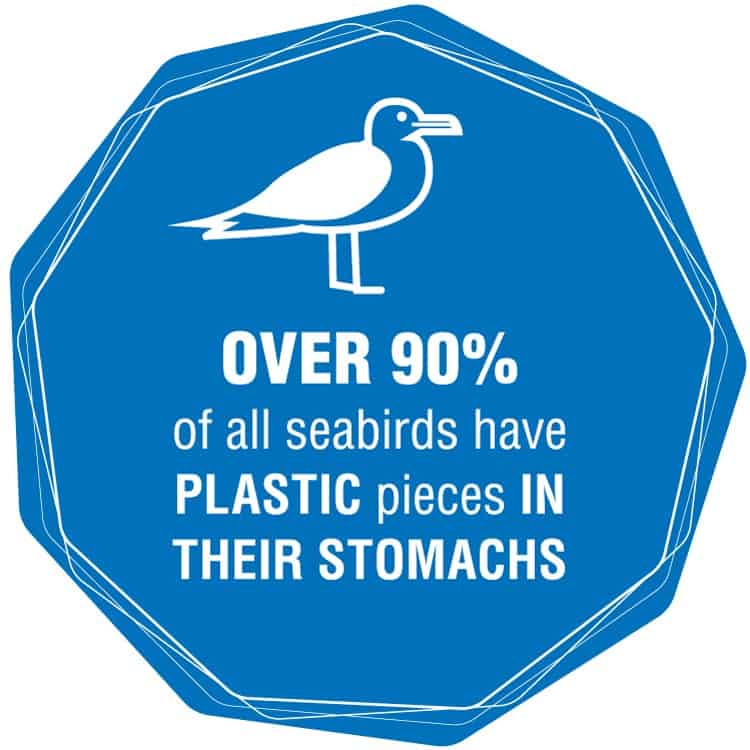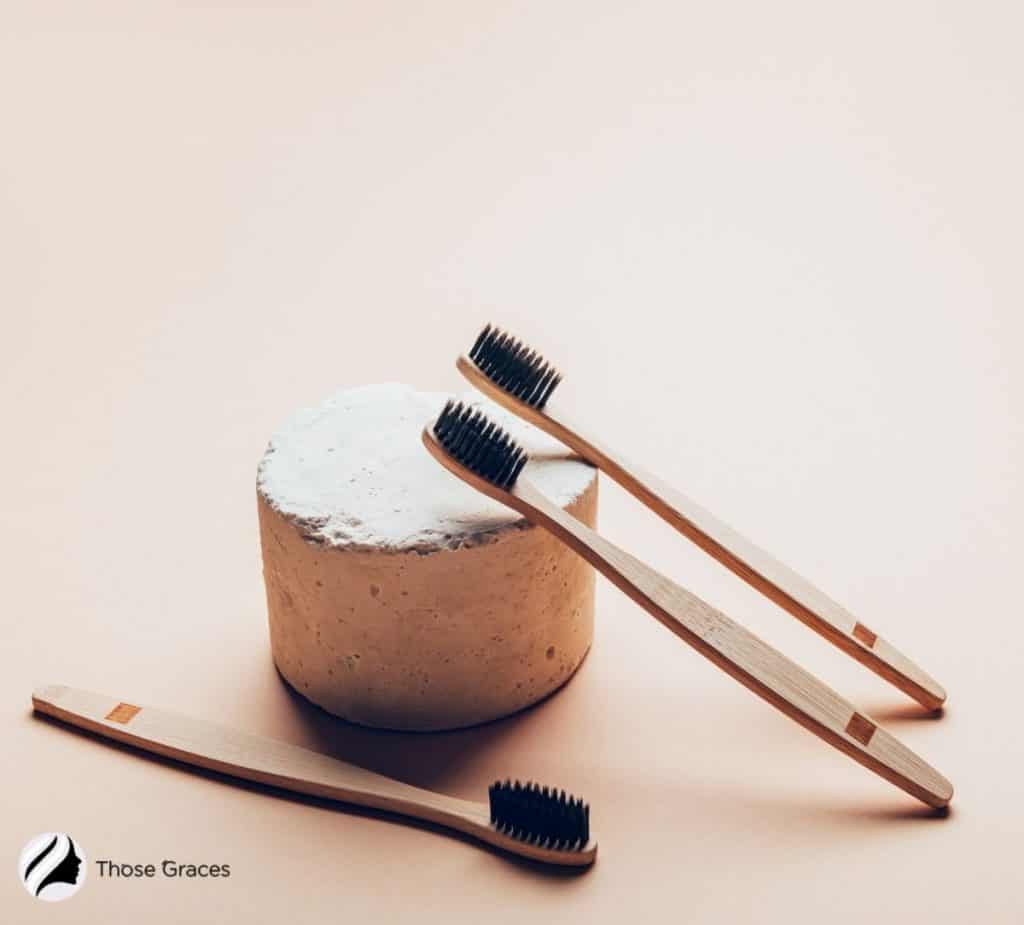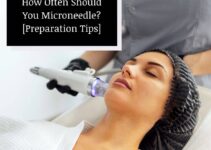Want a zero-waste beauty routine but don’t really know where to start?
We’ve got you covered!
Below, we’re going over some amazing tips and product recommendations that help you “go green” without sacrificing style.
We have a lot to talk about, so let’s jump right in!
Table of Contents
How to Create a Zero-Waste Beauty Routine
Did you know that, according to Plastic Oceans, less than 9% of the 380 MILLION tons of plastic produced each year actually gets recycled?
The rest ends up in landfills, oceans, seabirds, and even in your own stomach. I’m not kidding. You eat roughly 40 pounds of plastic each year! Gross, right?
While your beauty routine isn’t solely responsible for all of that plastic pollution, it definitely plays a contributing role.
Think about it: everything from your shampoo and conditioner to your toothpaste to that adorable new eyeshadow palette comes packaged in plastic.

A recent study found that we’re nearing an irreversible tipping point with plastic pollution that threatens our planet’s entire future.
So, now more than ever, we need to do whatever we can to “green” all of our routines and take better care of Earth.
Here are 10 tips that will help get you started.
FYI, this post includes affiliate links. If you buy through them, we earn a small commission at no extra cost to you.
1. Use up what you have and replace with zero-waste as you go
It’s tempting to start greening your routine by going on a purge, but that’s really the worst thing you can do.
After all, throwing out perfectly useful things is pretty much the OPPOSITE of going zero-waste.
Instead, just use up what you already have. Finish that bottle of shampoo, squeeze out every last bit of that toothpaste.
Don’t throw away all of those packages yet, though. There’s one more step to do before swapping everything out with zero-waste options.
2. Determine which packaging you can reuse
While it’s kind of hard to reuse an empty toothpaste tube, there are definitely other types of packaging that can find a second (or even a third, fourth and fifth) life in your bathroom.
For example, the plastic container that held your favorite body butter from Bath and Body Works can easily become a container for homemade sugar scrubs.
Just rinse it clean and sterilize it with some rubbing alcohol before using it for something else.
For things that you can’t reuse for your homemade beauty products, search Google or Pinterest to find creative ways to recycle them.
An empty shampoo bottle, for example, can become a sink caddy or a pencil holder with a few well-placed snips and some fabric or paint.
Once you’ve done these two things, it’s time to start swapping in zero-waste health and beauty products for the ones you’ve used up.
3. Pare down your beauty stash and buy only what you’ll actually use
I’m almost ashamed of how many beauty products I’ve bought over the years before switching to a more eco-friendly routine. Just my mascara stash alone takes up an entire drawer!
One brand thickens, one lengthens. One resists smudging and the other lets me have a good cry without making me look like a raccoon. One even has little magnetic bits that do all of the above and then some.
The funny thing? I naturally have long thick lashes (don’t hate me, believe me, I have plenty of other beauty flaws), so really all I need is the one good waterproof option.
The same goes for the rest of my makeup, plus my haircare and body products. I have WAY too much that I’ll never be able to use before it goes bad.
So, I’m still in the process of going through steps one and two. In the meantime, I’ve significantly cut back on buying anything new.
When I do need to buy something, I ask myself if I really NEED it and if I have anything else that can do the same thing.
For example, I can use my zero waste shampoo and conditioner bar as a shaving bar for my legs, or my stash of wash-out conditioner to DIY my own leave-in detangler spray.
4. Ditch the single-use mentality
Sure, that single-use sheet mask or those facial cleansing cloths are super-convenient, but that convenience comes at a very high price.
We use billions upon billions of single-use products every year, many of which are either made of or wrapped in plastic and as mentioned above, more of it ends up in oceans than recycling plants.
Use up what you have, then switch to zero waste makeup remover. For example, instead of cleansing wipes, use a good facial soap and a real washcloth.
Rather than one-time-use face masks, use rice paper, seaweed, and other biodegradable “sheets” to make your own. Search Pinterest for “DIY sheet mask” for ideas or check out this video:
5. Invest in plastic-free or refillable makeup brands
When it comes to zero waste makeup, you have two major options.
One, go for a brand that’s completely eliminated all plastic from its packaging. They’re tricky to find, but they do exist.
Option two is often easier to find: brands that use refillable packaging. While the initial purchase may have some plastic in it, after you buy the container you just pop out the old stuff and pop in the new stuff.
Here’s a pro-tip: you can save money (and waste) by using packages from other brands that you saved from step 2.
I rarely buy the product that comes with the container. Instead, I just get the refills and find something that I have here to put them in.
If you don’t have any usable old makeup containers, something like these bamboo utensil drawer organizer trays can work well, too. You can make little dividers with recycled cardboard to keep everything neat.
6. Switch to a plastic-free toothbrush and toothpaste
Do you know how you’re supposed to switch out your toothbrush every three months? Well, consider this: there are roughly 330,150,000 people in the US right now.
If every person follows that recommendation, that means we’re tossing roughly 1,320,600,000 toothbrushes in the garbage every single year.

Switch to a more eco-friendly option, like these bamboo toothbrushes from The Humble Company and you’ll help keep at least some of that plastic out of the ocean.
While you’re at it, ditch the tubes and go with a zero waste toothpaste brand.
There are actually quite a few of them, including brands that look and feel like regular toothpaste (in other words, not just powders or tablets).
7. Swap out bottles for bars
Whether it’s a bottle of body wash, shampoo, or lotion, 9 times out of ten you can replace it with a zero-waste bar.
I’m old enough to remember when everyone started switching to body wash because some commercial claimed that bar soap was “drying.” I can’t remember who’s to blame for spreading this myth, but it’s bunk.
The right bar soap isn’t just more eco-friendly than body wash, it’s better for your skin, too.
Plus, unlike that poof that you use to spread around your body wash, a bar of soap is far less likely to collect bacteria.
Swapping out body wash for soap is simple. Other things take more getting used to. Shampoo and lotion bars, for example, have a bit of a learning curve.
Still, once you try them, you’ll never go back to the bottled stuff.
Check out this video for other zero-waste bathroom essentials:
8. Choose products made from eco-friendly ingredients
Going zero-waste isn’t just about choosing the right packaging (or lack thereof, as is often the case). It’s also about choosing products made from ingredients that won’t harm the earth.
After all, plastic isn’t the only thing that ends up in oceans and landfills. Go for clean, green, and natural ingredients as often as possible.
If you don’t want to go the 100% natural route, at the very least, make sure you avoid the worst offenders. These include:
- Exfoliating microbeads (they’re actually little balls of plastic)
- Formaldehyde
- BHA and BHT
- Synthetic fragrances (the word “synthetic” can mean anything, including undisclosed nasty chemicals)
- Phtalates
- Triclosan (it helps create antibacterial-resistant superbugs)
- Silicones (aka Siloxanes)
All of these ingredients can either harm the planet, you, or both.
If you’re having a hard time shopping for CLEAN products, here’s my secret: EWG Skin Deep Database. I run every single product that I’m considering buying through it to check the rating.
A low rating is better than a high one. So, something with a score of 1 is way better than a product with a score of 10.
9. Go cruelty-free
While not all cruelty-free products are also zero-waste (or even “clean”), really dedicated brands know that being animal-friendly isn’t just about not testing on bunnies.
These companies want to help save ALL animals, not just those in laboratories, so they focus on reducing their impact on the entire planet.
After all, a product can’t really call itself cruelty-free if it contains ingredients that kill marine animals.
Choose companies that actually started with a mission to create CF products, not just the big names that jumped on the bandwagon when people stopped buying their cruelly tested products.
While it’s great that companies like L’Oreal and J&J are trying to go cruelty-free, their packaging, ingredients, and overall practices still wreak havoc on the planet.
10. Shop online responsibly
While I’m all about supporting small businesses and shopping locally, I don’t really live in an area that offers much in the way of zero-waste products, so I have to buy online.
That, of course, comes with a slew of its own problems. Between the shipping boxes, the plastic bubble wrap, and the fuel used to deliver my package, I wonder if I’m doing more harm than good sometimes.
For the most part, experts say that online shopping can actually be greener than in-person shopping. I think that’s especially true if you have to drive a long distance to shop.
Still, I do try to mitigate the problem as much as possible on my end, too. For example, if I’m buying from Amazon, I use their “Amazon Day” shipping feature so that I get as few packages as possible in one day.
I also look for Etsy shops that use eco-friendly packaging to ship items. Bonus points if I find one that plants a tree or something for every purchase.
Conclusion
Switching to a zero-waste beauty routine takes effort, but not as much as you might think. It’s not only the right thing to do for the planet, but it’s good for you and your budget, too, in the long run.
References:
- “Cosmetic Products Are Full of Plastic – Beat the Microbead.†2017. Beat the Microbead. February 15, 2017. https://www.beatthemicrobead.org/cosmetic-products-are-full-of-plastic/.
- Giselle La Pompe-Moore. 2019. “The Beauty Industry’s Plastic Problem: What Exactly Is Being Done about It?†Byrdie. 2019. https://www.byrdie.com/plastic-packaging-beauty-industry.
- Hoff, Victoria. 2021. “18 Ingredients a Clean Cosmetic Chemist Would Avoid.†Byrdie. 2021. https://www.byrdie.com/toxic-beauty-ingredients-4782646.
- “Is Global Plastic Pollution Nearing an Irreversible Tipping Point?†2021. ScienceDaily. 2021. https://www.sciencedaily.com/releases/2021/07/210701140931.htm.
- “Resources – Info | Plastic Oceans International.†2020. Plastic Oceans International. October 22, 2020. https://plasticoceans.org/plastic-pollution-info-resources/.
- Watson, Kathryn. 2020. “Is Body Wash Better than Bar Soap?†Healthline. Healthline Media. September 28, 2020. https://www.healthline.com/health/beauty-skin-care/bar-soap-vs-body-wash.

What are your favorite zero-waste beauty tips? Share in the comment section below!



